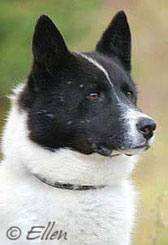Russian European Laika

Russko-Europeiskaja Laika
FCI group 5, section 2, standard 304
General
The Russian-European Laika is the smallest of the 3 Laika breeds. It is an all-round hunting dog, used for hunting big and small game but originally used for hunting squirrels mainly.
Due to his exterior, this breed can easily be recognized. However, the Russian-European Laika is closely related to the Karelian Bear Dog which makes it difficult to distinguish both breeds.
The Russian-European Laika is smaller, has a considerable lighter bone and is
almost square-built. The Karelian Bear Dog is used for hunting big game and his entire appearance should give the impression that he is capable to do so.
A double, hard and weather resistant coat is of high importance. The Russian-European Laika is always black or dark grey with white. It does not matter how the colours are divided over the body, but ticking is not desired. Dominating white colour is only allowed if at least the head is black.
Origin
The Russian-European Laika finds its origin in the area between Finland and the Uralian mountains, mainly around Archangelsk, Komi Republic and Karelia.
Originally, different colours appeared, like wolf grey, karamis, red, white or white patched. Black and white dogs existed, but, remarkably enough, they were not very common. It took until the 1960’s, before the majority of the dogs was black and white.
Per region there were several
varieties, with minor differences in body structure, size of ears, coat and colour. Some of these types are: Karelian Laika, Komi Laika, Zyryan Laika, Votyak Laika and Archangelsk Laika.
In this breed’s development, there was also some mixture with West Siberian Laika blood.
The first official breed description dates from 1947, the present one is from 1980.
Standard
|
The Russian-European Laika is a medium-sized, slightly rectangular, strong, dry and agile dog. |
|
| Head |
Relatively small in shape, approaching an equilateral triangle. Dry and strong muzzle; |
| Teeth |
Scissor bite, teeth white and strong; |
| Eyes |
Small, oval, slanting, dark in colour; |
| Ears |
Pricked, pointed; |
| Neck |
Muscular, dry, length near to that of the head; |
| Body |
Strong and muscular back, short, slightly arched loins, strong bones. Broad croup, not long and slightly sloping. Deep, well developed chest. Belly markedly tucked up; |

| Limbs |
Straight front legs, well defined angulations in shoulder and upper arm, pastern elastic. Strong, well angulated hind legs; |
| Feet |
Oval with strong, tight toes, dew claws are not allowed; |
| Tail |
Either sickle or ring tail, carried over back or buttocks; |
| Movement |
Typical for the breed is gallop, alterning with short trot; |
| Coat |
Hair of top coat hard and straight, well developed under coat. Short and close fitting on the head and ears. Longer on the neck, withers and shoulders, forming a beard on the cheek bones and a stand-off collar on the neck. On the front side, the limbs are covered with short hair, on the rear side it is longer, but does not form any feathering; |
| Colour |
Black, grey, white, grizzle, dark with white patches, white with dark patches, ticking on the limbs and red colour are undesirable; |
| Height |
Male dog 52-58 cm Bitch 48-54 cm |
Character
The Russian-European Laika is open and friendly, very affectionate and loyal to the family and the herd. Towards children he is exceptionally tolerant. He may keep aloof towards strangers. He has a strong territorial instinct and may display aggressiveness towards unfamiliar
dogs intruding his territory. He only fights for a reason and in a fair way.
The Russian-European Laika is a dog with a lot of temperament, often finding some reason to bark.
This dog is not difficult to train, when taught using soft and friendly methods, avoiding hard treatment.
Hunting skills
The Russian-European Laika has a very strong developed hunting instinct and has a very good sense of direction. Due to that, he will always be able to find his way back. The Russian-European Laika is among the most efficient dogs treeing any small game that hides in trees, like squirrels, marten and related game. Also, he can
be used for hunting big game, such as bear and moose. By using his scent (either in the air or by tracking), the dog perfectly knows how to find game. Once game is found, the dog prevents it from moving by baying it, so that the hunter is able to approach it without any problems.
Health
The Russian-European Laika is a healthy breed. Not many health
problems occur, although some cases of epilepsy are known.
Important
The Russian-European Laika is a lively dog with a very good endurance. He needs a lot of exercise, and needs to run off-leash. If this is not the case, he will try and find another - mostly not a positive - way to lose his energy.
Moreover, every Laika has at least a good (but often an excellent) hunting instinct. This means that there is a high chance that the dog will chase game as soon as there is an opportunity. Because of his hunting method, it is not unlikely that the owner needs to be patient for a couple of hours, before the
dog will return. In many countries this is not allowed and a dog hunting solitary and without permission can even be shot.
Therefore it is very important that, when choosing a Laika, one should realize that the natural looks should not be the only important fact. Along with it comes natural behaviour and this may not be convenient in all situations. Especially when keeping a Laika as a family dog only, there are some consequences to it, like finding a way for the dog to lose its energy and to use its hunting instinct.



